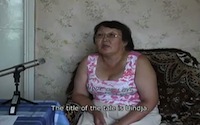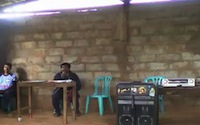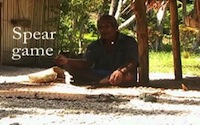Waima’a has a very complex phonological inventory compared with other languages from East Timor, or indeed compared with most Austronesian languages anywhere else. It has a four way contrast with different manners of articulation for stops: the variety spoken in the village of Caisido has voiceless unaspirated, voiceless aspirated, voiceless ejective, and plain voiced stops. You can listen to some of the contrasts between different consonant types by clicking on the link here. The five vowels found are straightforward: a, e, i, o, u.

Ejective stops are not at all common in Austronesian languages, although they are widespread in parts of Africa and North America. The only Austronesian language in which ejectives have been reported (apart from Waima’a) is Yapese (Jensen, 1977). More details on this feature of Waima’a can be found in Hajek and Bowden (2001). Ejective stops are formed by first closing off the glottis, creating a body of air in the vocal tract that can be moved. An upward movement of the glottis then forces this air from the mouth, creating the characteristic sound of an ejective.
Waima’a has not traditionally been written, and the complicated phonological contrasts have made it difficult for literate locals to even think about writing their own language (although they are happy to read and write other languages). The Waima’a team has submitted a proposal for an orthography to the East Timorese National Institute of Linguistics for their evaluation. The proposal is summarised on what follows of this page. At the present time, this work is still highly provisional. The exact phonetic characterisation of some segments remains problematic, but all of what seem to be the important contrasts are listed here to facilitate comprehension of the texts found in other parts of this site. Sound files illustrating some of the more ‘difficult’ sounds can also be downloaded and listened to.
Waima’a has 34 consonants, and 5 vowels. All of the vowels occur in indigenous words, but some of the consonants only occur in borrowed words. The table below lists the orthographic symbols (i.e. letters of the alphabet) which are used to represent the relevant Waima’a sounds, rather than phonetic symbols. Linguists should be able to get an idea of what the symbols represent phonetically by looking at the descriptions of the sounds found in the first column. Those sounds which are inside brackets only seem to occur in borrowed words.
Provisional Waima’a orthography
| Labial | (Post-) alveolar |
Velar | Glottal | ||
| Stops | voiceless unaspirated | (p) | t | k | ‘ |
| voiceless aspirated | (ph) | th | kh | ||
| voiceless ejective | p’ | t’ | k’ | ||
| voiced | b | d | g | ||
| Fricatives | plain | (f) | s | h | |
| glottalised | s’ | ||||
| Nasals | plain | m | n | ||
| voiceless | mh | nh | |||
| glottalised | m’ | n’ | |||
| Laterals | plain | l | |||
| voiceless | lh | ||||
| glottalised | l’ | ||||
| Rhotic | plain | r | |||
| glottalised | r’ | ||||
| Glides | plain | w | |||
| voiceless | wh | ||||
| glottalised | w’ |
References
Hajek, John and John Bowden, 2001. A phonological oddity in the Austronesian area: ejectives in Waimoa. Oceanic Linguistics, pp…
Jensen, John Thayer, 1977. A reference grammar of Yapese. Honolulu: Oceanic Linguistics.
© The Research School of Pacific and Asian Studies, the Australian National University.
International students: ANU CRICOS provider number is 00120c
Please direct all comments or suggestions to the maintainer, John Bowden.
This page last modified on 10 January, 2003.







